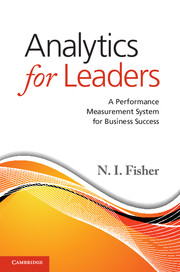Book contents
- Frontmatter
- Dedication
- Contents
- List of exhibits
- Preface
- Acknowledgments
- 1 How’s your due diligence?
- 2 Introduction to the system
- 3 A framework for performance measurement
- 4 What is Stakeholder Value?
- 5 Adding Value for Customers
- 6 Adding Value for People
- 7 Adding Value for Partners
- 8 Adding Value for the Community
- 9 Adding Value for the Owners
- 10 What to report and how to report it
- 11 How to get started . . .
- 12 The Performance Measurement Framework: Assessment and adoption
- 13 Practical aspects of managing Stakeholder Value
- 14 Performance measurement for Small and Medium Enterprises
- Appendix Don’t be fooled by statistics
- References
- Index
13 - Practical aspects of managing Stakeholder Value
Published online by Cambridge University Press: 05 December 2013
- Frontmatter
- Dedication
- Contents
- List of exhibits
- Preface
- Acknowledgments
- 1 How’s your due diligence?
- 2 Introduction to the system
- 3 A framework for performance measurement
- 4 What is Stakeholder Value?
- 5 Adding Value for Customers
- 6 Adding Value for People
- 7 Adding Value for Partners
- 8 Adding Value for the Community
- 9 Adding Value for the Owners
- 10 What to report and how to report it
- 11 How to get started . . .
- 12 The Performance Measurement Framework: Assessment and adoption
- 13 Practical aspects of managing Stakeholder Value
- 14 Performance measurement for Small and Medium Enterprises
- Appendix Don’t be fooled by statistics
- References
- Index
Summary
O wad some Power the giftie gie us
To see oursels as ithers see us!
Robert Burns
PREAMBLE: AN ONGOING DIALOG WITH THE STAKEHOLDER
Relationships are sustained if the partners to the relationship remain in contact, whether by telephone, letter or email, or personal meetings. And your relationships with your stakeholders are no different. You need some form of ongoing dialog with each of the stakeholder groups. The frequency and nature of the dialog may vary, but it has to take place.
The generic process for managing Stakeholder Value provides an ideal vehicle for a constructive dialog. Indeed, a communications plan is an essential concomitant of a properly implemented Value management process, and we’ll discuss this explicitly in Section 13.6 below. The most compelling example of such a dialog is a People Value process (although the same applies to all the other stakeholder groups), so it’s helpful to look at the steps in the process (Exhibits 13.1 and 13.2) to see the dialog developing (Exhibit 13.3).
Experience with this process confirms strongly that, even in the most hostile of environments (e.g. a university)
there is a large initial and beneficial impact of involving people in the design of the instrument, they enjoy the Focus Groups2 and also tell other people what they’ve been doing and why; and
people will continue to participate in follow-up surveys provided that management responds to the results promptly and sensibly.
- Type
- Chapter
- Information
- Analytics for LeadersA Performance Measurement System for Business Success, pp. 169 - 196Publisher: Cambridge University PressPrint publication year: 2013



